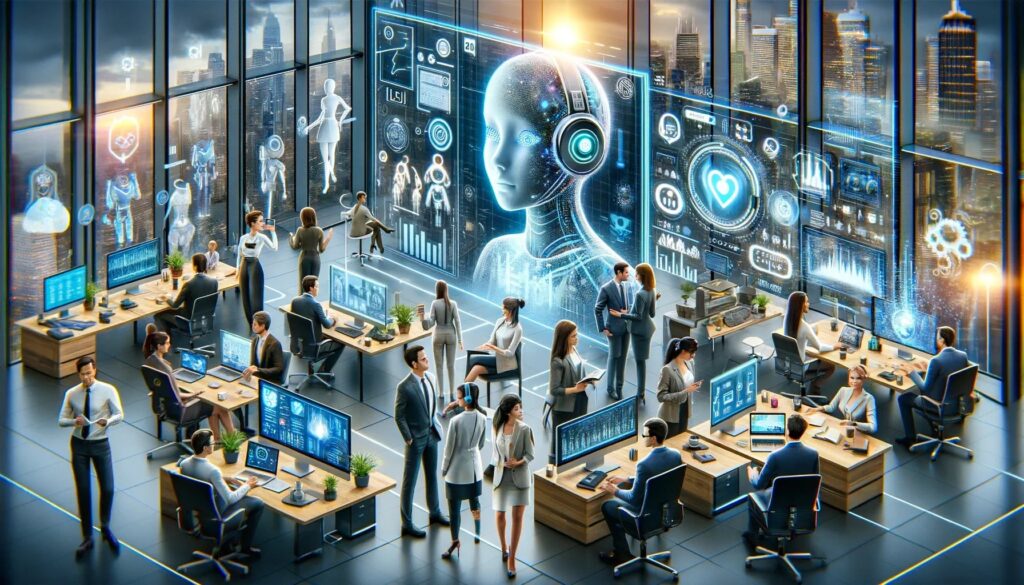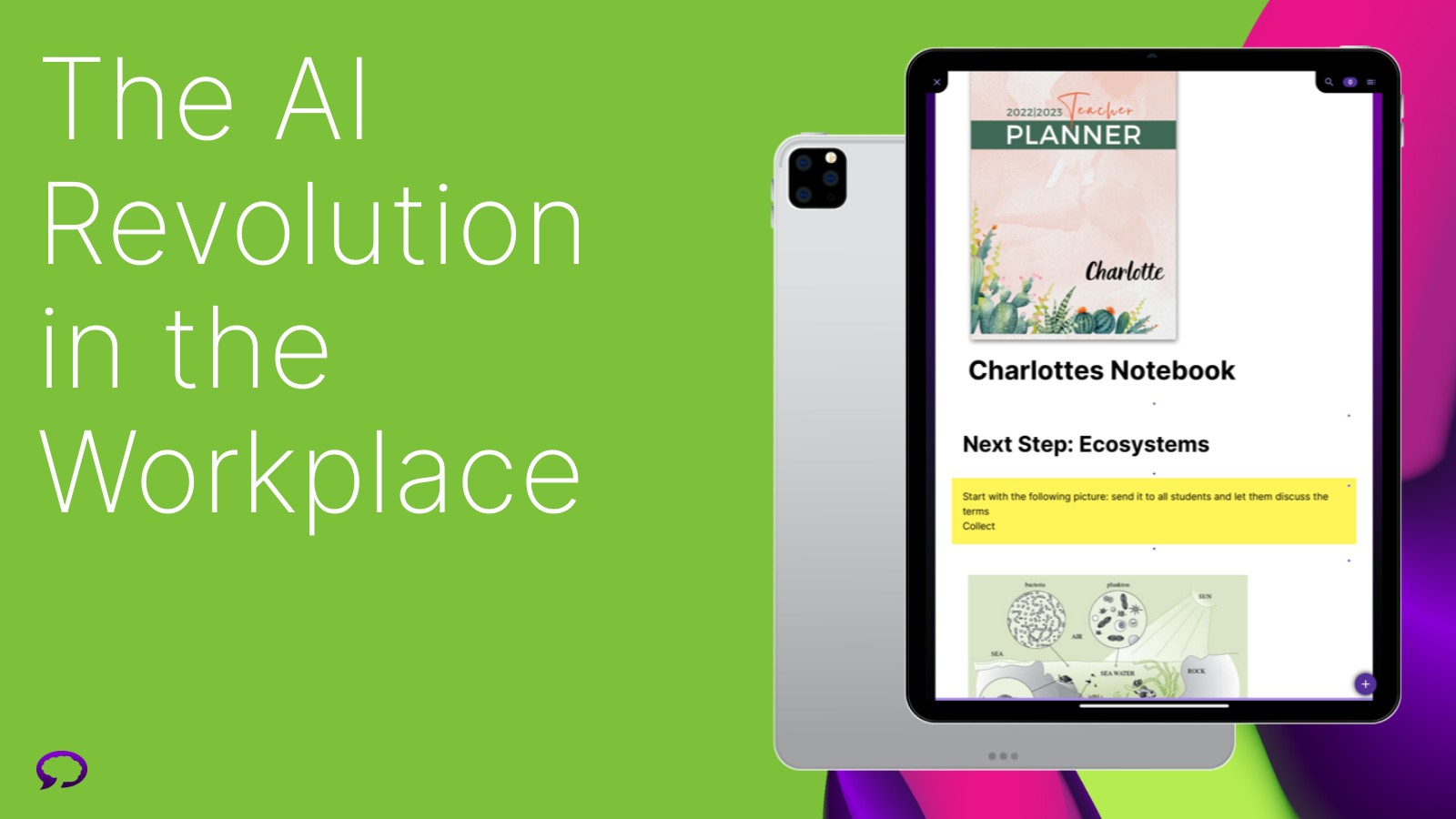This week, I came across Julia Hobsbawm’s Bloomberg article titled “AI, Metaverse, Chatbots: Workplace Trends to Watch for in 2024.” One aspect that particularly resonated with me was the comparison of AI’s impact on our work to the monumental changes brought about by the internet. With tools like ChatGPT, which now boasts a staggering 100 million users weekly according to OpenAI, it’s clear we’re in the midst of a fundamental shift. Hobsbawm observes that these AI tools “will only get more sophisticated,” heralding a significant transformation in our daily work experience.
This evolution, much like the leap from typewriters to word processors, introduces a steep learning curve. I reflected on this in my previous blog, “Does AI have the potential to put ‘Learning’ back into Learning and Development?” where I delved into AI’s role in crafting personalized training experiences.
On a personal note, AI has revolutionized how I approach tasks. It’s become an invaluable sparring partner, challenging my ideas and perspectives, and a tool for streamlining efficiency through research and analysis. Whether it’s synthesizing vast amounts of information or offering diverse viewpoints, AI has enhanced my ability to stay ahead and remain updated in a rapidly evolving period of time. Its impact extends beyond mere efficiency. It has fundamentally changed the way I think, plan, and execute tasks, marking a new era in how we approach work and problem-solving.

The Corporate Learning Curve and AI’s Dividend
Hobsbawm, in her article, addresses the significant challenges the corporate sector faces in keeping pace with AI advancements. She points out a notable knowledge gap about generative AI across industries, despite its profound impact. This isn’t an isolated challenge, it’s a widespread issue, demanding strategic upskilling and learning across various sectors.
She writes, “Generative AI has risen to become an equal and increasing priority for global organizations in comparison to the enterprise priorities of hybrid working and providing flexible work environments.” This observation highlights a crucial modern skill: the ability to adapt to and leverage AI. Just like the advent of personal computers in the 1990s transformed office work, AI today demands similar adaptability. In my interactions, I’ve noticed a spectrum of responses to this technological evolution. Some embrace it eagerly, while others approach it with caution, hindered by concerns about security or the unknowns of this new technology.
The reality is, mastering AI is not just about keeping up with the latest tech trends, it’s about remaining relevant and competitive in a rapidly changing world. Hobsbawm’s insights remind us that this is more than a technological shift — it’s a cultural and skill-based transition. Those who adapt and learn will forge ahead, while those who hesitate might find themselves struggling to catch up. This period mirrors the transition in the ’90s when computers started dominating workplaces. Just as it was then, the willingness to embrace and understand new technology will define success in this AI-driven era.
Chatbots and Voice-Activated AI
Hobsbawm’s article delves into the shift toward voice-activated AI, signifying a major transition from typed queries to more natural, conversational interfaces. She brings in Henry Coutinho-Mason’s prediction, stating, “the next frontier of interactive and query-able chatbots is going to be voice activated.” This evolution indicates a future where AI blends more seamlessly into our daily routines, making interactions with technology more intuitive and user-friendly.
The scope of voice-activated AI goes well beyond its current use. The prospect of AI providing personalized experiences through customized chatbots is quickly turning into a tangible reality. This progression is set to transform how we engage with information and manage our digital tasks. On a personal level, I’ve found great efficiency in using voice-to-text as prompts for AI tools like ChatGPT. It’s not just a time-saver, it’s a glimpse into the potential advancements we’re likely to see in 2024. This integration of voice-activated technology in our everyday tools hints at a significant leap forward, where the creation of unique digital assistants isn’t just a possibility, it’s an impending change that will enhance productivity and personalize our interaction with technology in unprecedented ways.
The Immersive Metaverse Experience
In her article, Hobsbawm highlights the emerging significance of the Metaverse in transforming digital interactions, especially within the workplace. She illustrates how Meta Platforms Inc. envisions the Metaverse as a novel center for workplace training and brainstorming, signifying a major shift from traditional work environments. This immersive realm, according to Hobsbawm, is set to make professional experiences far more engaging and productive than our current models.
The integration of virtual reality and augmented reality technologies, underscored in Nick Clegg’s LinkedIn post, points to a future where our digital and physical workspaces might merge. Such a blend suggests a wealth of opportunities for interaction, creativity, and productivity, potentially redefining our engagement with workspaces.
From my perspective, while I am deeply involved in next-generation Ed-Tech and I am no stranger to technological advancements, I remain cautiously optimistic about the Metaverse’s immediate impact on our daily work lives in 2024. The widespread adoption of VR in everyday professional settings feels more like a leap into science fiction than a near-term reality. While the potential is undoubtedly there, the practicality and readiness of such technology for broad workplace integration might still be a few years away. However, as with any prediction in the fast-evolving tech landscape, only time will tell if my reservations hold true or if the Metaverse will indeed take us by surprise sooner than anticipated.
AI in Talent Acquisition
AI’s role in talent acquisition is a trend that Hobsbawm highlights in her article. Platforms like Upwage are at the forefront of this transformation. The “Super Screener” developed by Upwage exemplifies how AI is streamlining the hiring process, especially for hourly wage workers, making recruitment more efficient and accessible. This innovation is a clear indicator of the future role of AI in seamlessly matching talent with the right opportunities.
Yet, as Hobsbawm points out, the potential for automated biases in AI-driven hiring is a significant concern. This highlights the critical importance of maintaining ethical standards in recruitment practices. As AI becomes increasingly integrated into talent acquisition, it’s essential to ensure these technologies are employed in a way that upholds fairness and inclusivity.
From my own perspective, I see AI’s integration into recruitment as an inevitable and massive shift. Already, Applicant Tracking Systems (ATS) have been utilized for years, but the potential of AI goes much further. I envision a future where AI not only analyzes resumes and LinkedIn profiles but also plays a crucial role in evaluating online interviews. While this technology exists, its extensive use in recruitment is still in its nascent stages. However, the trend is clear: AI is poised to take on roles traditionally held by humans in this field. The skill of understanding and leveraging AI for recruitment will soon become indispensable. Just as AI has revolutionized other aspects of our work, its impact on talent acquisition will likely be profound, potentially elevating the process to new levels of efficiency and precision.
Conclusion
In conclusion, Julia Hobsbawm’s Bloomberg article offers a thorough exploration of the substantial changes that AI, the Metaverse, and chatbots are bringing to our workplaces. These advancements are reshaping not only our current practices but also charting the course for a future rich with potential and innovation. The real challenge we face is adeptly navigating this new digital terrain, continuously upskilling to meet its ever-changing demands, while ensuring that the human touch remains at the core of our work.
One key area that Hobsbawm’s article doesn’t specifically touch on, but is integral to these changes, is the realm of learning and development. This is where the work we’re doing at Get More Brain becomes particularly exciting. By transforming legacy content into engaging learning experiences and leveraging AI, we’re taking personalization to a whole new level. This approach not only enhances the learning experience but also aligns it more closely with the evolving needs of today’s workforce.
I invite you to join me on this journey as we explore the evolving landscape of work and learning. For more insights and discussions on these topics, please follow me on LinkedIn and Medium. At Get More Brain, we’re committed to staying at the forefront of these changes, ensuring that learning remains a dynamic, personal, and impactful part of your professional growth. Let’s embrace the future together, with open minds and a readiness to adapt to the exciting opportunities it brings.
This post was first published on Medium.


